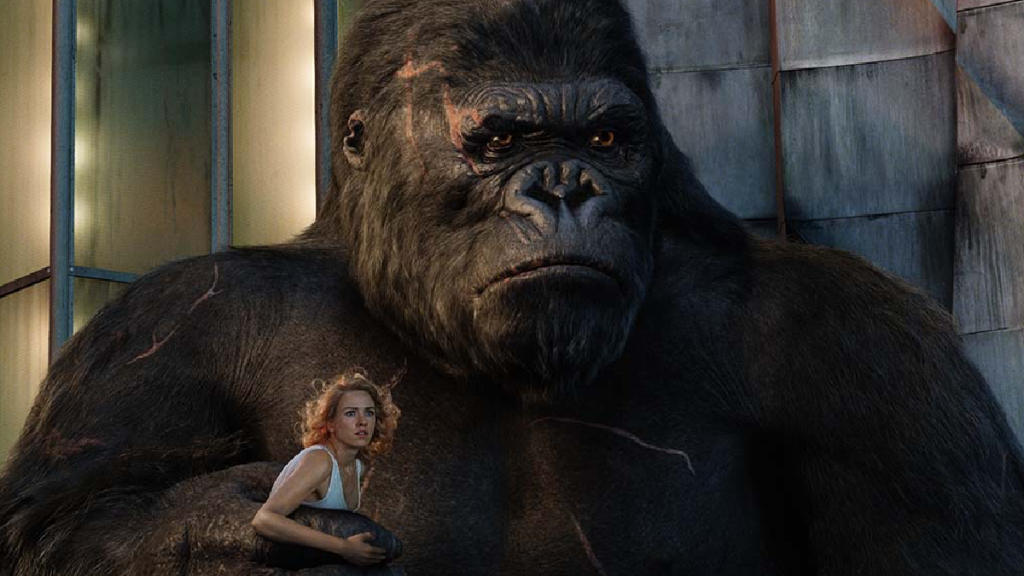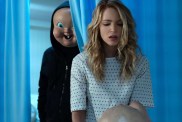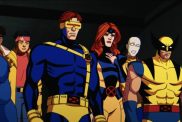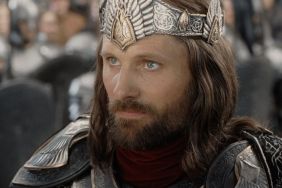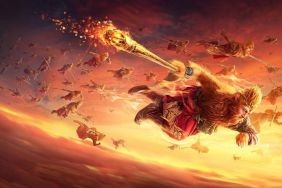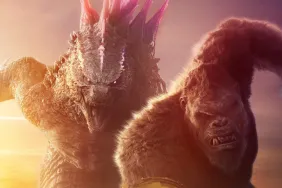After the massive success of The Lord of the Rings: Return of the King, acclaimed director Peter Jackson had to decide go bigger or smaller for his next picture. But when given the chance, Jackson leaped at the chance to remake King Kong. Kong was a passion project he’d initially worked on before diving into Middle Earth. Except now — armed with a $200M+ budget — he could more or less do what he wanted without nervous executives looking over his shoulder.
Peter Jackson’s original pitch for Kong was more in the style of 1999’s rollicking The Mummy with Brendan Frasier. That approach was enough for the up-and-coming director of Heavenly Creatures and The Frighteners. By 2003, however, Jackson was a critically acclaimed, award-winning filmmaker. A simplistic, crowd-pleasing blockbuster wouldn’t suffice.
So, Jackson concocted a sweeping, action-adventure/drama with state-of-the-art special effects, a sprawling cast, gorgeous visuals, and a Kong-sized runtime more in line with Titanic than The Mummy. Jackson’s Kong was big, bold, poetic, and leaned heavily on many of the same visual flourishes and storytelling techniques that shaped LOTR into a groundbreaking smash.
Alas, the Eighth Wonder of the World failed to wrestle the box office from the competition, namely runaway hit The Chronicles of Narnia: The Lion, the Witch and the Wardrobe and Harry Potter and the Goblet of Fire. Kong swung into theaters on Dec. 14, grossing $218M domestically and $556M worldwide — not bad, but far from the billion-plus total amassed by Return of the King.
Jackson overestimated Kong’s universal appeal—audiences clearly like the big guy, as Kong: Skull Island and Godzilla vs. Kong will attest. Just not enough to sell billions of dollars worth of tickets at the box office.
Initial Reaction
I couldn’t wait for King Kong. Outside of Revenge of the Sith, it was my most anticipated film of 2005. I grew up with King Kong and Godzilla and was eager to see them brought to life with proper special effects. I saw Return of the King 12 times in theaters. Yes, 12. I was mesmerized by Peter Jackson’s filmmaking and couldn’t wait for his encore. I watched interviews and production diaries; I bought the soundtrack and that two-disc DVD release of the original King Kong, where Jackson meticulously recreated the spider-pit sequence. My brother and I ran down to GameStop to buy the PS2 adaptation of the film. Check out these stunning visuals:
Damn, that was a long time ago. I digress. Did the remake live up to this hype?
Sadly, no.
I enjoyed King Kong—well, most of it. The special effects were mind-boggling, and the action was larger-than-life. I was satisfied, but not blown away. Multiple viewings did nothing to alter my perspective. King Kong was good, and that was about it. Sure, I purchased the DVD, then the Special Edition DVD and Blu-ray. The film always lingered in my collection, but I ignored it over the years — aside from snippets I’d see on TV.
But nearly 20 years later, I decided to fire up King Kong one Saturday night and was quite surprised.
On Second Watch
In dire need of something to entertain my 8-year-old daughter a few weeks back, I clicked on King Kong and promised her an adventure with lots of monsters. While she eventually tapped out after the first 60 minutes, Kong’s spectacle grabbed my attention and never let go.
The first hour worked for me on this go-round. I appreciated Jackson’s efforts to present engaging, well-rounded characters like Ann Darrow (Naomi Watts), a struggling actress desperately seeking a break, Carl Denham (Jack Black in a criminally underrated performance), a down-on-his-luck director willing to risk it all for his craft, and Jack Driscoll (a miscast Adrien Brody), a writer-turned-hero who falls for Ann.
Less appealing is the weird relationship between Evan Parke’s Hayes and Jamie Bell’s Jimmy. Jackson and screenwriters Fran Walsh and Philippa Boyens go to great lengths to flesh out the two seamen but provide no payoff to their overly dramatic exchanges. Hayes dies, and Jimmy vanishes in the third act.
Ditto with Kyle Chandler’s goofy Bruce Baxter, an arrogant actor who predictably tucks tail and runs when the shit hits the fan. Surprisingly, he redeems himself with a last-second rescue but then inexplicably reverts to his smug ways in the third act, where he goes back to acting like a goon.
Jack’s journey hits just as many bumpy patches. Based on the scene’s requirements, the man morphs back and forth from a cocksure writer to an invincible hero. Ann unfairly casts him aside despite his willingness to travel through Hell to save her life. Their climactic embrace feels a little forced.
Other negatives include the infamous Brontosaurus stampede, which looks just as bad today as in 2005. Peter Jackson was under a lot of pressure to complete the film for Christmas, to the point of exhaustion, leaving several effects rushed or unfinished. Some of this sequence looks great, but the integration of the actors (who are clearly running on treadmills in front of green screens) never thoroughly convinces.
Finally, as mentioned above, the third act jettisons most of the characters we spend so much time getting to know. The original King Kong uses a similar time jump, and it works because we only care about Ann (Fay Wray), Carl Denham (Robert Armstrong), and Jack Driscoll (Bruce Cabot). No time is wasted on the supporting cast, primarily used as monster fodder. In Jackson’s Kong, I wanted to see what happened to Jimmy, Captain Englehorn (Thomas Kretschmann), and Preston (Colin Hanks). How did their journey on the island impact their personal lives? Why wouldn’t they appear at Carl’s presentation? Why spend so much time making us care about trivial characters?
King Kong is far from perfect, but it excels where it matters most: Ann and Kong’s relationship. Watts (who deserves more recognition for her stellar work here) goes for broke and believably captures Ann’s turmoil—she’s a woman inexplicably in love (sort of) with a giant ape. The fact that we feel bad for and care about Ann speaks volumes about Watts’ performance.
Then there’s Kong himself, a magnificent creation that ranks up there with Gollum and Caesar as one of the greatest entirely CGI characters ever conceived. Coincidentally, all three characters are played by the great Andy Serkis. Kong looks incredible, right down to his expressive eyes and ragged, battle-worn fur.
And in dramatic beats, such as when Ann and Kong take a break from the action for some Christmastime ice skating:
You never doubt the pair’s feelings for one another, as crazy as that sounds. When Jackson focuses on this relationship, King Kong soars. Too often, he unnecessarily shifts into horror mode with moments, like the spider pit, that detract from the narrative:
Jackson also recreates the classic log sequence from the original Kong. Except here, the beat leaves us scratching our heads. Is Kong supposed to be a monster or a gentle giant? The V-rex fight occurs immediately after Kong murders Ann’s friends—are we supposed to cheer for the giant ape or fear him?
No matter. By the time we reach the climactic third act, Peter Jackson is firing on all cylinders, proving why he’s one of the best in the business. Here, the director combines thrilling action with tender character beats and coats it all with tragic foreboding. When Kong climbs the Empire State Building, it is portrayed as an inevitable outcome resulting from his attraction to a beautiful woman. His fate was sealed long ago.
Then comes the film’s best set piece: Kong vs. a squadron of heavily armed planes, a sequence that ranks among modern cinema’s most incredible action scenes. Here, Weta’s VFX truly shines; everything pops from the subtle glow of the sunrise to the breathtaking aerial shots of New York. I live for this kind of cinema, and I’m surprised it didn’t affect me as strongly on previous viewings.
Make no mistake: King Kong is flawed, bumpy, bloated, and disjointed. Jackson is stuck between two films—an action-packed monster picture and a complex drama. Still, King Kong dazzles more often than not. It may not be the home run Peter Jackson and Universal envisioned, nor does it reach the same heights as LOTR. Still, King Kong stands tall as an incredibly ambitious piece of filmmaking.
A tip of the cap and apologies to Mr. Jackson. You did Kong proud.
